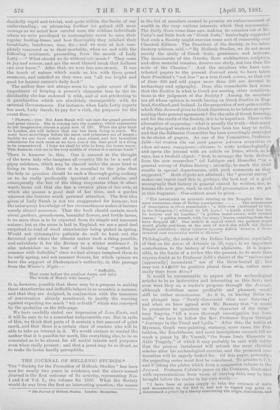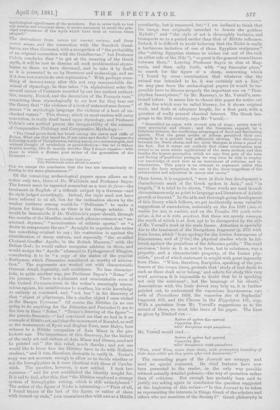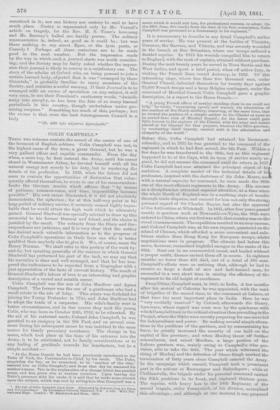THE JOURNAL OF HELLENIC STUDIES.*
'Tux "Society for the Promotion of Hellenic Studios" has been now for nearly two years in existence, and the above-named Journal is the first outcome of its activity, representing NOs. 1 and 2 of Vol. I., the volume for 1880. What the Society would do was from the first an interesting question ; the names • The Journal of Uganda audios. London: Macmillan.
in the list of members seemed to promise au embarrassment of wealth in the very various interests which they represented. The Daily News some time ago, making its occasion out of Mr. Paley's sad little book on " Greek jests," banteringly suggested that such a Society might exercise some sort of censorship over Classical Editors. The President of the Society, in his intro- ductory address, said,—" By Hellenic Studies, we do not mean merely the study of Greek texts, grammars, and lexicons. The monuments of the Greeks, their architecture, sculpture, and other material remains, deserve our study, not less than the texts of the Classics." And the members who have con- tributed papers to the present Journal seem to have taken their President's "not less " as a true Greek gEi6nro;, so that out of their 300 and odd pages more than 250 are devoted to archasology and epigraphy. Does this remarkable fact mean
that the Realien in what is Greek are ousting other cousideras tions in the judgment of the Society P Among its members
are all whose opinion is worth having on Greek Studies in Eng- land, Scotland, and Ireland. Li the proportion of not quite a sixth,
which this JOuratai gives to Greek literature, to be taken as repre- senting their general agreement? For the sake of Greek learning, and for the credit of the Society, it is to be hoped not. There is the alternative of supposing—what is usually the truth;—that many
of the principal workers at Greek have been too busy to write, and that the Editorial Committee has been accordingly restricted in its choice of papers. As one of the Committee, Professor
,JTebb_i erorar; 1441 1,4E1' xcapiraa, freixarroa Einrpocx-47\TO...
(14,ace caraince; wapix4,um;—elioose3 to write archmologically, and opens the journal with an article on Delos, which, as h
says, has a, twofold object : "first, to arrange the facts derive( from the new researches" (of Lebbgue and Homolle) "in a general survey of Deliau history ; secondly, to mark the chief results in special departments, with such comments as they suggested." Both objects are attained; the "general survey " makes one regret (and this is, perhaps, the best test of a good monograph) that history in general cannot be written, nor, as human life now -goes, read, in such full presentation as we get in this fragment. One extract must be given :— "Thu inventories or accounts relating to the Temples form the most numerous class of Delian inscriptions The minuteness
of description is often remarkable little cow [dedicated to Isis, in the Serapoion F] without its left horn;' ' a kettle which has lost its bottom and its handles;' ' a golden laurel-crown, with twisted leaves;' ' a golden wreath, with [so many] leaves, counting those that have dropped off.' Ono article is named which the modern world would gladly purchase, at the cost of much else whicfli the Deliau Temple contained,-875xnv ,rpf-ysayny gxovvar, 131/3xia ANtiatov, a three. cornered case containing storks ofAlcaeus."
Philologically, the notice of the Delian Inscriptiens, especially of that on the ApiToz5 of Artemis (p. 59, swig.), is an important contribution to the history of Greek alphabets. It is impos- sible, in the limits of a review like the present, to do more than express doubt as to Professor Jebb's theory of the " various and
[apparently] inconstant" use of the three-barred 9 ; but may not AAB ON be genitive plural from cix1);, rather more
easily than from oç P
It would be unreasonable to expect all the archamlogical articles to be as instructive and interesting as this first; and.
oven were they so, a reader's progress through the feseme/, although doubtless more profitable and pleasant, would still be rather monotonous. As it is, on leaving Delos we are plunged into "Newly-discovered sites near Smyrna( and when we have agreed with Mr. Ramsay that "it would be premature to speculate on the character of the rains" near Smyrna "till a, more thorough investigation has Weu made," we have to follow the Res'. Professor Sayce through "Journeys in the Troa,d. and Lydia." After this, the tombs at lelycertae, Greek vase-painting, statuary, more vases, the Pen- tathlon, the Erechtheum, and more inscriptions succeed, till we reach a paper by Mr, Verrall, "On Some Ionic Elements in Attic Tragedy," of which it may probably be said with safety that the present instalment will refresh the mere classical scholar after his archreological exercise, and the promised con- tinuation will be eagerly looked for. Of this paper, presently ;
the preceding series must first be considered. To articles 0, 7, 8, and 0 elong the plates which form a companion volume to the journal, Professor Colvin's paper on the Centaurs, illustrated with representations from vases of varying date, may be best brought before the reader in his own words :—
"I have been at pains simply to take the evidence of texts and monuments as we find it, and not to regard any point as determined aprioni by a theory concerning the origin, derivation, and
mythological significance of the monsters. But in order both to test our results and complete thorn, it seems necessary to recall the prin- cipal explanations of the myth which have been at various times adopted."
The derivations from xiiireim (or zerray) von;pouc, and 'from s.sprfis aCpas, and the connection with the Sanskrit Gand- harva, are then discussed, with a recognition of " the probability of au original connection with the Gandharvas ;" but Professor Colvin concludes that "to get at the meaning of the Greek myth, it will be best to dismiss all such problematical etymo- logies as those we have discussed, and to take it by itself,
AS it is presented to us by literature and archreology, and see if it does not contain its own explanation." With perhaps some- thing of inconsistency after this not very commendable dis- missal of etymology, he then takes "in alphabetical order the several names of Centaurs recorded by our two earliest authori- ties, namely, Hesiod, and the decorators of the Francois vase," examining them etymologically to see how far they bear out the theory that "the violence of a host of untamed man-horses" means "in mythologic language the violence of a host of un- checked waters." This theory, which to most readers will carry conviction, is really itself based upon etymology, and Professor Colviu's own method proves the inseparability of the sciences of Comparative Philology and Comparative Mythology :—
" The Cloud pours forth her brood among the caves and cliffs of Pelion. What can that brood be, if not rains and floods ? Compare the "following words of Theophrestos, writing purely as a meteorologist, and without thought of symbolism or personifleation—Tav 4n1 rliXtov Ne0An Two*, 1;Bee irpoeiCy 4PTED8EP 158cop 4vettov olukafvfl—with those in which a Roman poet writes of the generation of the 1 Centaurs :-
'Illh senliferos INionidng Ceutauron rota Pulethrouiim pubes efliulit In antris.'
Can we escape the conclusion that the two are unconsciously re- :furring to the same phenomenon ?"
Of the remaining archtcological papers space allows us to notice only two, those of Dr. Waldsteiu and Professor Sayce. The former must be regarded somewhat as a tour de force—the treatment in English of a difficult subject by a German--and its style judged accordingly. Indeed, the style need not have been referred to at all, but for the inclination shown by the weaker brethren among would-be " Hellenists " to make a jargon for things Greek, as there is for things artistic. It would be lamentable if Dr. Waldstsin's paper should, through the mouths of the Maudles, make such phrases common as" un- adorned dryness," "accentuation of athletic sports," or "a desire to compensate the eye." As might be expected, the writer has something original to say ; his contention is against the identification of many statues, and especially "the so-called Choiseul-Gouffier Apollo, in the British Museum," with the Delian God ; be would rather recognise athletes in them, and would assign the "Apollo " aforesaid to Pythagoras of Rhegion, 'considering it to be "a copy of the statue of the pugilist . Euthymos, which Pausauias considered so worthy of admira- tion," The arguments are worked out with characteristic German detail, ingenuity, and confidence. No less character- istic, in quite another way, are Professor Sayce's "Notes" of his journeys. There is a pleasant and unmistakable aura of the Oxford Common-room in the writer's amusingly uncon- scious egoism, his sensitiveness to weather, his wide knowledge so entirely at command, and "not less" in his discovery of that "object of pilgrimage, like a similar object I once visited in the Basque Pyrenees." Of course the Hittites (is no one going to do anything for the Jebu sites and Perizzites?) are to the fore in these "Notes." "'Texier's drawing of the figure"— the pseudo-Sesostris—" bad, convinced me that we had in it an example of Hittite art, and that the monument of Karabel, as well as the monuments of Erik and Boghaz Keui, near Halys, bore witness to a Hittito occupation of Asia Minor in the pre- historic age. The importance of this discovery, for the history of the early art and culture of Asia Minor and Greece, need not be pointed out" (for this relief, much thanks ; and yet one would. like to know how the Hittites have to do with Hellenic studies), " and. it was, therefore, desirable to verify it. Texier's sleepy was not accurate enough to allow us to decide whether or not the hieroglyphics in it were identical with those of Carche- mish. The question, however, is now settled. I took two squeezes—" and for ever established the identity sought for„ It is sad to find, after this, that "the Hittites employed a strange system of hieroglyphic writing, which is still undeciphered." The notice of the figure of Niobe is interesting :—" First of all, I found traces of the feet of the figure, or rather of shoes with turned-up ends," (one remembers this with awe as a Hittite
peculiarity, but is reassured, for) " I am inclined to think that the image was originally intended to denote the goddess I-Cybel6;" and "the style of art is thoroughly barbaric, and transports us to a period earlier than that of Hittite influence. Indeed, it is difficult to avoid believing that the Nioba is really a barbarous imitation of one of those Egyptian sculptures" (the "sitting Egyptian statues in niches cut out of the rock on either side of the Nile "), "so great is the general resemblance between them." Leaving Professor Sayee to dine at Mag- nesia, and then sally forth, with "my binocular glass," to search for the figure of a sheep, concerning which "I found by cross - examination that whatever else the animal was intended to be, it was certainly not a lion," we may pass from the archasological papers (it would be im- possible here to discuss properly the important one on " Pam- phylian Inscriptions," by Mr. Ramsay), to Mr. Verrall's, men- tioned before. It seems fair to choose this paper for notice out of the five which may be called literary, for it shows original work, and deals at adequate length, for a first part, with a question of really general classical interest. The Greek lan- guage in the fifth centnry, says Mr. Verrall,—
" Resembled an organ with several sets of slops ; poetry was at once provincial and classic ; and the literature enjoyed, by a felicitous balance, the conflicting advantages of fixed and fluctuating speech. That the great artists of Athens perceived their own - strength is in a general way sufficiently obvious. The distinction between the Doric chorus and the Attie dialogue is alone a proof of the fact. But it seems not unlikely that closer examination may reveal to us more subtle applications of the same method, and that besides the keener perception which we may thus gain of the tone and feeling orparticular passages, we may even be able to employ our knowledge of such laws as an instrument of criticism and in- terpreLation. This paper is an attempt to represent under this aspect the facts respecting the use by the thee tragedians of the substantives and adjectives in -ocruvos and -mien."
These forms, it is suggested, " were in their free development a characteristic mark of the Greek spoken in Asia ;" and "in
tragedy," it is tried to be shown, "these words are used in such circumstances only as point to language and literature of Asiatic
growth or descent." In the able and thorough-going development of this theory which follows, we get incidentally some valuable suggestions of emendation, noticeably on the IOU 1099 (.1es gi; OGINII for Ad);l,mrat'Sm), and on the Troades 590 (rosliz irodos ,hiAtzy, Z, for oi irodor 1,heyAAca). But these are merely Irtiparia,
the worth of which is at first apt to be disregarded by the side of Mr. Verrall's work at his main theme. Attention is specially due to the treatment of the Euripidean fragment (p. 272) with Ionic forms, which "is an apology for the Ionian Anaxagoras of Klazomenae, and of [Hot.] the physical studies which he fol-
lowed, against the prejudices of the Athenian public." The word (.4eAfrnpec," Ionic as it is, not in form, but in substance, was a property, and a characteristic property, of the Ioniau phy- sicists," proof of which statement is sought with great ingenuity from Plato. " When, therefore, Euripides, speaking of the pro- fessors of the imps 06aloc, protests that study of foul deeds to such as these shall ne'er belong,' and selects for study this very word 4,EXirn,ttoc, it is impossible to doubt that he is speaking not only the sentiments, but the language of his clienti."
Associations with the Ionic spvssisai may help us, it is further pointed out, to understand. the Trn,uosOPect‘ Cuyacizsoverat ,rai; Tong of Prometheus 1058, the ripssoot;ses piss of Sophocles' fragment 658, and the Chorus in the Hippolytus 161, Bev. With a quotation from Mr. Vessel's suggestions as to the second of these, we must take leave of his paper. The lines as given by Dindorf run :— Xfaivos a; xp4vos tilha Kparcuct TEpAtorriwg 1310a i1-AA' Ityeuptatici POO /ARt0/.16014.
Mr. Verrall would read :—
XpdPos a xpsy. &i4 Kparanfi Tepi.Locr6wq roXX' avevptcricelY pawalvous, Time, cruel Time, mows them, down, with peremptory bounding of their days, while yet they yearn after rich discoveries.' " The succeeding pages of the Journal are scrappy, and need no special comment. Its chief features have now been presented to the reader, in the only way possible without actually detailed polemie,—the way of quotation rather than of criticism. But enough has probably been said to justify our asking again in conclusion the question suggested at the beginning of this review—" Is this Journal to be taken as representing the interests in things Greek of the scholars and others who are members of the Society ?" Greek philosophy is
unnoticed in it; nor can history nor oratory be said to have much place. Poetry is represented only by Mr. Verrall's article on tragedy, for the Rev. H. S. Tozer's love-song and Mr. Ramsay's ballad are hardly poems. The solitary representative is, indeed, as good as it could be ; but was there nothing to say about Epos, or the lyric poets, or Comedy P Perhaps all these omissions are to be made good in the next number. But the impression made by the way in which such a journal starts was worth consider- ing; and the Society may be fairly asked whether the impres- sion their journal is likely to convey is a satisfactory one. The story of the scholar at Oxford who, on being pressed to join a certain learned body, objected that it was "swamped by those Orientals," is probably familiar to many members of the Society, and contains a useful warning. If their Totowa/ is to be swamped with an excess of specialism on any subject, it will very soon, to use their President's cautionary words, "dwindle away into atrophy, as has been the fate of so many learned periodicals in this country, though undertaken under pro- mising auspices." Something too much of this, perhaps ; but the excuse is that even the best heterogeneous Council is a
body of; ob8i Tp)s X‘70VTES Itl04LEOQ."




































 Previous page
Previous page